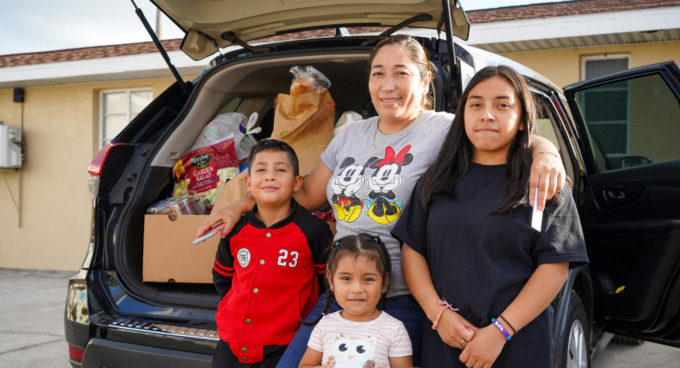In early 2020, COVID-19 spread across the United States, leading to an economic downturn that has left many of our most vulnerable communities — including children — more at risk of going hungry. In fact, Feeding America projects that 13 million kids (1 in 6) may experience food insecurity in 2021 due to the pandemic and its aftermath.
The good news? As Congress prepares to vote on new COVID-19 recovery legislation, lawmakers have an opportunity to ensure the legislation includes much-needed investments in proven pathways to helping kids access the healthy food they need to grow, learn, and thrive, including the Summer Electronic Benefits Transfer (EBT) program and the expanded Child Tax Credit.
Additionally, our policymakers should expand the Community Eligibility Provision (CEP) — a move which would help 9 million additional kids access free school meals.

Victoria at a mobile pantry.
Below, learn more about CEP and why an expansion of the program in any COVID-19 relief package is a must – and not something to put on the chopping block.
What is the Community Eligibility Provision?
CEP is a critical tool that allows high-poverty U.S. schools and schools districts to serve school breakfast and lunch at no cost to all enrolled students, effectively getting more meals to more kids and getting rid of the need for schools and school districts to receive and process burdensome school meals paperwork. Right now, the program is available to schools and school districts with at least 40 percent of students participating in the Supplemental Nutrition Assistance Program (SNAP) or other similar programs.
Why is the Community Eligibility Provision a valuable tool for keeping kids nourished?
Many families with children eligible for free meals do not apply for them due to stigma or difficulty with the school meals application process. By eliminating the application process altogether, CEP helps to remove a major barrier between children and access to nourishing food — and helps free up time for school meal operators to focus more on providing healthy meals and less on dealing with administrative burdens.
Additionally, by making all students eligible to receive meals at no charge in a school or school district, CEP supports families who, otherwise, make too much to qualify for free school meals but still need food support. CEP also removes the need for school districts to collect unpaid meal fees from families, removing challenging situations for school meal programs and families alike that have sometimes led to “lunch shaming.”
What opportunities do our lawmakers have for strengthening the Community Eligibility Provision?
In upcoming COVID-19 recovery legislation, Congress has a golden window of opportunity to:
- Lower the eligibility threshold for CEP from 40 percent to 25 percent;
- Expand automatic enrollment in the program; and
- Increase program funding.
By implementing the above policy changes, lawmakers could strengthen CEP and help provide free school meals to an additional 9 million kids. As children across the country continue to face hunger — jeopardizing their academic success, making them more vulnerable to developmental impairments in areas like language and motor skills, and potentially leading to more social and behavioral problems — our key decision-makers cannot turn their backs on this pivotal chance to reduce child hunger.



